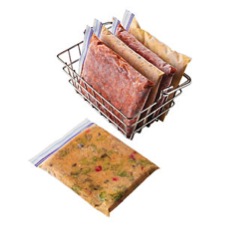Save the Soup with Soup-sicles!

Nothing is as good in nippy fall weather as coming home to a bowl of hot soup! You can leave some soups cooking in the crockpot, but some recipes that is just not a possibility. I also love to cook ahead, or double a recipe so that we have an extra easy meal. Doing this avoids eating out unnecessarily, and helps our family eating healthier, and food budget trimmed. I like having the option to pull something out of the freezer on hectic days, but still knowing that my family gets healthy foods, made with ingredients I can actually pronounce rather than packed full of additives, chemicals and sodium. If any of these sound like you, or like something you might want to do, the following tips can help you store that extra soup!
My first tip for freezing soup is to use a quality zip top bag. This will further the freezer life of the soup as well as preventing leaks and popped zip tops. Second, in bag preparation, using a permanent marker, write the date, and name of recipe on the bag before you fill it or freeze.
How to Freeze Soup
1. Cool.
Refrigerators and freezers cannot cool soups quickly enough to be food safe. Speed up the cooling process by placing the pot of soup in a bath of ice water
in the sink. Stir soup often to help release the heat.
2. Package. Label and date gallon- or quart-size zip-top plastic freezer bags, place in a bowl, and cuff the bag over the edge. Ladle soup into each bag, then let out any excess air and seal.
3. Freeze. Lay bags flat in a single layer in the freezer; when frozen, stack bags to save space.
4. Reheat. Thaw overnight in fridge. Reheat chowders over low heat; gumbo, stew, and Hearty Italian Soup over medium-low. Stir occasionally.
This is the same method I use for storing vegetable soup base, stocks and even spaghetti sauce. The flat stacking is a huge space saver.
I prefer to undercook pastas and rice in recipes that are destined for the big freeze, to avoid the mushy consistency later. For shellfish in recipes, I omit that and add it in the warm up stage. If you like to keep the meal all together, for example, when I am making a shrimp soup or a wonton soup, I tightly wrap the shrimp or flash frozen wonton, add it to a zip bag, and when the broth part of the soup is frozen flat, I stack them and rubber band them. This way everything is still together when I am ready to prepare them.
I find it is very easy to add these soup-sicles to a cold crockpot by opening the zip top, breaking the seam on one side and peeling the plastic back and off the chunk of soup. Heating the soup over low keeps the soup from continuing to cook too long, as any type of pasta or rice will get mushy. It is also important to note that soups that have a creamy base made require additional liquid to return to the original consistency.

Using containers to freeze soup is another option but I prefer to use the ziptop bags because when freezing anything, air is your enemy. Air or space is what allows ice crystals to form and burn your frozen goods. Putting warm soups into freeze will also encourage ice crystals to develop. There is a suggested one month freezer life for soups, but I have frozen many for several months and they have survived quite tastefully.
- https://www.southernliving.com/food/how-to/how-to-freeze-and-store-soup
- https://momonamission.me/crock-pot-minestrone-soup-freezer-friendly/
 Sharon Ng
Sharon Ng
Monthly Newsletter Contributor since 2012
Email the author! sharon@dvo.com
